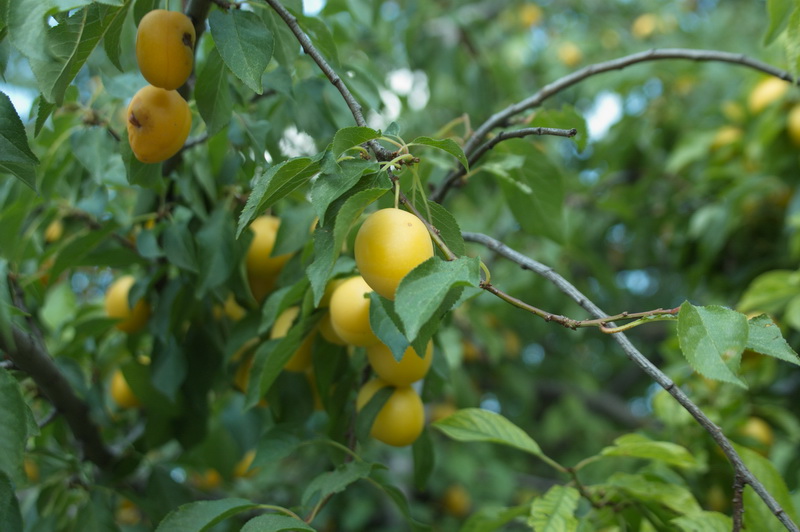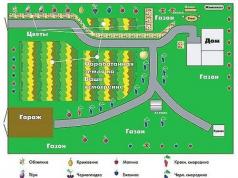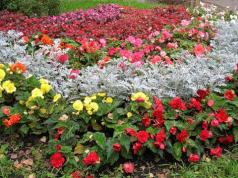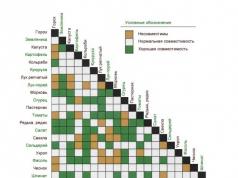Cherry plum Plum splayed varieties description photo fruits, planting, propagation, care, application, beneficial properties, distribution. Cherry plum is a type of plum that has become an independent fruit crop. Sometimes it is called plum splayed.
Cherry plum or plum
Latin name Prunus divaricata Ledeb.
Description
Cherry plum or spreading plum - Prunus divaricata Ledeb. A tree up to 10 m tall, with a low, often curved trunk, or a large shrub up to 4 m tall. The crown is thick,
The flowers are white, small, the fruits are yellow or dark red, small, edible, sour.
Blooms in early May, bears fruit in July–August.
Cherry plum is very early-bearing and, moreover, has high, fairly regular yields. Flower buds are formed on annual seedlings in the nursery. The first fruits appear a year after planting in the garden. In the 3rd - 4th year, the yield from the tree increases to 30 - 40 kilograms, and by the age of 10 it reaches 300 kilograms or more. It is characterized by an extremely large amplitude of ripening of varieties: from particularly advantageous, unusually early (on a par with apricot) - June to late autumn, October. No stone fruit crop has such a length of ripening period except peach.
The fruits of the cherry plum are extremely diverse: with a weight ranging from 6 grams in wild forms to 30 - 60 grams in modern varieties. They can be spherical or oval, with shades of color from purple to red, yellow and green. But, unfortunately, even the best varieties of cherry plum have fruits that are inferior in quality to plums. As a rule, they are too sour.
Spreading
Cherry plum or plum Under natural conditions, it is widespread in Central Asia, Transcaucasia, the Northern Caucasus, Crimea, Ukraine,
Teberdinsky reserve To. On the edges, clearings and mixed deciduous forests, mainly in the northern part of the reserve, 1500-1700 m above sea level. Usually.
Cherry plum or plum splayed growing
Highly winter-hardy and drought-resistant (excellent), not resistant to pests and diseases (satisfactory). Blooms regularly and bears fruit abundantly, self-seeding (excellent). Photophilous, undemanding to soils, salt-resistant, dust- and gas-resistant.
The homeland of the cherry plum is areas with arid and hot climates, which makes it drought-resistant. On this basis, cherry plum is superior to cherries and plums, but inferior to apricots and peaches. It also stands out for its heat tolerance. In dry winds, when, for example, the leaves of an apple tree curl up, those of a cherry plum tree remain tight and green. In the wild, cherry plum grows mainly in deciduous mountain forests, where it occupies bright places at the edges of the forest, along slopes, and sometimes along river banks. Consequently, it is light-loving and has a powerful root system that penetrates the soil to a depth of 12 meters. A valuable quality of cherry plum is salt resistance.
The growing season of cherry plum is on average 220-225 days, the required amount of active temperatures is 3500-4000°C. When moving north, especially in cold years, the shoots ripen poorly. Therefore, hybrid cherry plum varieties that finish growing earlier, such as the Kuban Comet, are preferable here.
Cherry plum is grown in the form grafted and rooted trees. The advantage of self-rooted trees, like other crops, is the ability to restore the tree through root and stem shoots, which is especially important in more northern areas. In addition, a self-rooted plant that forms a multi-stemmed bush suffers less from freezing of the trunk and is less damaged by diseases. All this is especially valuable in amateur gardening.
You can get layering by hilling up the standard shoots. In Adjara, for example, for this purpose they use tops inside the crown, which are enclosed in a vessel with a hole at the bottom, filled with water. Cherry plum also takes root well from green cuttings, from which a standard seedling is formed in one year when grown. Rooting efficiency of lignified
cuttings depends on the variety.
In recent years, maple rootstocks have been introduced. For areas north of the industrial cultivation of cherry plum, it is recommended to test clonal rootstocks selected by the Siberian Research Institute of Horticulture named after M.A. Lisavenko: SVG 11-19, Utah Seedling, etc. These rootstocks are easily propagated by green cuttings, are characterized by medium vigor and are very winter-hardy. Promising clonal rootstocks CHAK-5-62, OP-23-23, OP-15-2 and OD-2-3, obtained from crossing cherry plum with cherry plum, as well as hybrids of alpine plum and peach, bred in the Nikitsky Botanical Garden. In these same areas, especially with sufficient moisture, the winter-hardy, weak-growing rootstock VVA-1 (cherry tomentosa), which reproduces well from green and woody cuttings, is promising.
Cherry plum is a good rootstock not only for itself, but also for plums, apricots, peaches, and almonds. However, it is also necessary to know the disadvantages of it as a rootstock: the vigorous growth of trees grafted on it, the abundant formation of root shoots, the relatively low frost resistance of the roots, which tolerate freezing of the soil at a depth of only -10... - 12°C.
Plum splayed Teberdinsky Reserve
Reproduction
Reproduces cherry plum seeds.
As a seed rootstock for cherry plum, only cherry plum is recommended, as well as its hybrids with Ussuri plum or Chinese plum. Seeds are stratified 4-5 months before sowing. Before stratification, they are soaked in running water for 3-5 days. At the beginning of stratification, the temperature is maintained at 18-20°C, but later reduced to O-10°C. The optimal stratification temperature is 3-7°C. Towards the end of this process, when the seeds begin to germinate, the temperature is reduced to 3-1°C. In the south, autumn sowing is also possible with unstratified seeds; in the north, it is better to stratify the seeds. When seedlings emerge, to ensure good growth, they are thinned out at a distance of 7-10 centimeters.
Chemical composition
Compared to plums, they are richer in biologically active substances: vitamin C, carotene, anthocyanins, catechins. They contain from 0.5 to 1.5 percent of pectin, which is especially important now for residents of industrial areas.
Cherry plum or plum splayed History of selection and varieties
Through centuries of selection and successive reseeding in different areas, varieties of folk selection were created. For a long time, cherry plum was grown only in small plantings in home gardens. The study of it as a fruit crop began only in the late 20s. Scientists began researching its wild forms and home gardens, while simultaneously relocating the best forms to collection gardens and studying them in detail in cultivation. Soon they began systematically breeding new varieties through hybridization. Based on the varieties created in the Nikitsky Botanical Garden, in the late 40-50s, the first industrial plantings of cherry plum appeared in the southern fruit growing zone.
Interest in neistut and the area under this crop. Currently, over 1,000 samples and 400 varieties are being studied at the Crimean Experimental Breeding Station of the All-Union Institute of Plant Growing named after N.I. Vavilov. More than 30 varieties are registered in zoning. Even in industrial plantings, it has gone beyond the limits of its natural range, spreading much further north: to the regions of the North Caucasus, Steppe Crimea, and a significant part of Ukraine. It is being tested in the Primorsky Territory, the Baltic States, Belarus, and some forms in central Russia.
It is distinguished by a wide variety of appearance of plants, their demands on growing conditions, and the quality of fruits. Therefore, scientists have divided this species into a number of subspecies. All cultivated varieties were grouped into a subspecies - large-fruited cherry plum. But even within its variety, the cherry plums turned out to be so diverse that they, in turn, had to be divided into well-defined groups: Crimean cherry plum, Armenian cherry plum, Georgian cherry plum, Iranian cherry plum, red-leaved cherry plum, Taurian cherry plum and hybrid.
The rapid introduction of cherry plum into industrial plantings was determined by the compliance of this crop with the requirements of modern intensive horticulture. It turned out to be one of the most profitable fruit crops, not inferior in this indicator to apple, peach, and plum.
 Sochi 1916
Sochi 1916 Depending on the quality of the fruit cherry plum varieties are divided into dessert, canning and universal.
For fresh consumption, the most valuable are the large-fruited varieties of hybrid cherry plum - Violet Dessert, Dessertnaya, Obilnaya, Kuban Comet. They are distinguished by their aroma, pleasant sweet and sour taste, and beautiful appearance. However, cherry plum is mostly used for processing: compotes, preserves, juices, jams, marmalades, jellies, dried fruits, as well as sour pita bread (tklapi) - thin sheets of fruit pulp dried in the sun. In the Caucasus, cherry plum fruits are widely used for preparing spicy seasonings - kvatsarakha, skatsebel, tkemali. At the same time, not only the fruits of cultivated cherry plums are used, but also wild ones.
Varieties with sour and intensely colored fruits are used for blending, which allows limiting the use of chemical components during processing. Particularly valued are varieties with a universal type of fruit, which can be used both for processing and fresh. The best among them are Vasilievskaya 41, Purpurovaya, Dessertnaya, Lykhny, Zhemchuzhina, Kubanskaya Comet.
The unusual property of cherry plums to cross with other types of plums and even representatives of other genera: cherries, sand cherries, apricots, and peaches is valuable for breeding. This opens up the opportunity to obtain a greater variety of both its varieties and other crops. I.V. Michurin, for example, crossed cherry plum with thorns. The plum itself apparently originated from the natural hybridization of cherry plum and sloe.
Cherry plum is a single-trunked or multi-trunked tree. In a culture, after the death of the grafted variety due to unfavorable conditions, it is formed from shoots in the form of a bush. Wild trees reach a height of 12-15 meters, grafted trees - from 4 - 5 to 10 meters. The lifespan of a tree for Armenian and Georgian varieties is 35-45 years, for hybrid cherry plum 20-25 years. As you move north, life expectancy decreases due to winter damage.
It is characterized as a southern culture with increased winter hardiness. It is believed that in terms of frost resistance of trees during winter dormancy, it is superior to peach and not inferior to southern varieties of plum, and when emerging from dormancy it is superior to apricot. Indeed, some of its forms, especially from high mountain regions, are able to survive winters even in the middle zone.
But two negative properties limit the possibilities of promoting it to these areas, and sometimes make cultivation difficult even in the southern zone. The first is a very short period of winter dormancy; already from the second half of winter, plants begin to lose frost resistance. Temperature changes at this time and in the initial period of spring can often be fatal for them, even in the southern zone.
The second negative property, which, by the way, follows from the first, is the early, at the same time as peach, almond and apricot, beginning of the growing season and, accordingly, very early flowering. Cherry plum blooms when temperatures accumulate at only 460-560 °C. Returning cold at this time can destroy flowers or already ovaries. True, cherry plum flowers withstand frost better than flowers of other stone fruits, tolerating temperatures down to -2 °C. The ovaries turn out to be more vulnerable, noticeably freezing at this temperature. Cherry plums are pollinated by insects, so early flowering, often coinciding with unfavorable summer conditions, is also a serious threat to the harvest. A way out of this situation: breeding self-fertile varieties and varieties with a later flowering period. Self-fertile varieties were obtained by crossing cherry plum with alpine plum. To develop late-flowering varieties, cherry plums are crossed with varieties of American, Alpine, and Chinese-American plums. Among the late-flowering varieties are Obilnaya, Comet, Traveler, Granite.
The most winter-hardy varieties are those with a long period of winter dormancy or those that retain frost resistance longer after emerging from it due to slow development: hybrid cherry plum varieties Kuban Comet, Traveler, Granit, Sarmatka, Gift to Friends, Naiden, Chuk, Lavina.
 Cherry plum leaves
Cherry plum leaves Cherry plum is a new, intensive type, industrial southern fruit crop. There is no doubt that she will acquire citizenship in amateur gardening, including to the north of her industrial breeding zone. Recommended for creative and limited consumer gardens in the fourth and fifth regions. The main direction of experimental work is the selection of the best forms and their consolidation for further cultivation in new areas, the study of cherry plum in order to improve rootstocks both for itself and for other stone fruit crops. Particularly interesting is the hybridization of cherry plums with representatives of stone fruits of other species and genera.
Cherry plum or plum splayed Application
Food
Mostly used for processing: compotes, preserves, juices, jams, marmalades, jellies, dried fruits, as well as sour pita bread (tklapi)
Decorative
It is also valued as an ornamental plant, which is primarily due to its early and abundant flowering. There are very impressive decorative forms - red-leaved, variegated, weeping, pyramidal. The most common are the red-leaved varieties of cherry plum pissard, in which not only the leaves, but the flowers and even the pulp of the fruit are colored pink or red. Unlike many garden forms, this cherry plum reproduces well by seeds, retaining its decorative properties. The value of cherry plum for ornamental gardening increases due to the fact that it tolerates urban conditions and pruning well. Due to the formation of a large number of offspring and a powerful root system, cherry plum is also used to strengthen all kinds of slopes. It is also good for hedges.
A plum spread out in the spring during flowering and fruiting is very decorative. Decorative durability 25–30 years.
Recommended for forming edges in parks, landscaping industrial areas, and forest reclamation plantings.
As a decorative plant, the long-cultivated form of cherry plum with dark purple leaves is more interesting ( Prunus
divaricata
f. atropurpurea
). It is also distinguished by dark cherry shoots, raspberry-cherry flowers and dark red fruits.
Honey plant
A beautiful and also very early honey plant. Its flowers secrete a lot of aromatic substances and nectar and are therefore visited by pollinating insects more readily than other fruit plants that bloom at the same time.








